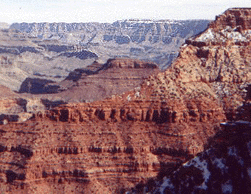
 | Here, the Colorado River has cut down two billion years worth of rock. One can get a glimpse of the processes that formed the North American content. The canyon is nearly a mile deep and varies from 600 feet to 18 miles in width. Its formation happened over a relatively short period of time, geologically speaking. The river was probably helped by major separations (faults) that accelerated the erosion of an ancient plateau, lifted up and twisted by the same forces that formed the Rockies. |
The geological record is not always complete. The Great Unconformity represents a gap of 1.2 billion years where rocks formed 1.7 billion years ago, of the same vintage as the Canadian Shield, touch rocks from 500 million years ago.
Limestone, shale and sandstone represent the end result of of sediment accumulated on the bottom of ancient seas and the remains of ancient sand dunes. There is also black basalt left behind by volcanic activity a "mere" million years ago. The rock formations have been given wonderful names like Bright Angel Shale and Vishnu Schist.
Even with all the hype, this is a truly special place. Sunrise from the south rim is worth seeing.
Major dams - Glen Canyon and Hoover - have substantially affected the complexion of the river. The Colorado was originally named for its red silty colour, due to the large amount of hematite (iron oxide) sediment that it carried. Also, over 90% of the natural flow of the river has been restrained.
|
|

|
![[home]](gsbann.gif)